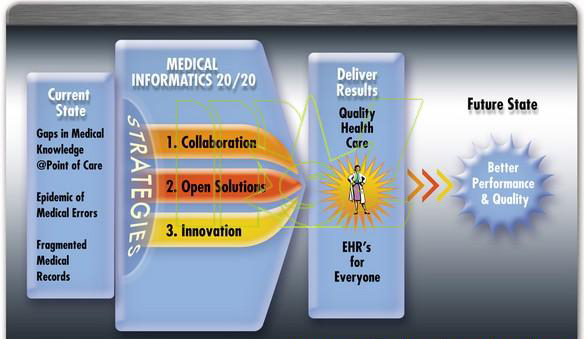Medical informatics, also known as health informatics, is an interdisciplinary field of study that emphasizes the use of computer technology to help organize, analyze, manage and use information in improving health care. Its chief goals are to develop standards and clinical guidelines, formalize medical terminology, enhance the usability of health information systems to facilitate communication and manage the flow of information from physicians to patients.
Medical informatics emerged as computer technology is applied to medicine, but has evolved to include applications from biostatistics, economics, business management, and cognitive psychology. German scientist Gustav Wagner developed the first professional organization for informatics in 1949. European countries began creating university departments and programs specializing in the subject. It was out until the 1960s, however, that the French coined the term” medical informatics” to formally define the field of health care informatics.
America followed suit in the 1970s with its own programs, which coincided with the appearance of large scale clinical information systems. The American Medical Informatics Association was founded in 1980s to provide support for this emerging discipline. Today, the National Library of Medicine funds medical informatics education at the graduate and post-graduate levels.

The main themes of medical informatics include standards, terminology, usability and demonstrated value. Developing standards and clinical guidelines for data collection is a critical component. Standardization of processes and guidelines helps ensure that health date is able to be integrated across information ensures that results can be measured and reported consistent across practices, institutions and regions, like comparing apples to apples rather than apples to oranges.
An effective health information system must pass the usability test. Usability refers to how easily a clinical computing system can be integrated into existing practices without disrupting the clinical workflow. The key to usability is an application that does not require too much to be learned. A health information technology solution that shows demonstrated value, the last core theme, is one that crates measurable results which can be used to reduce costs and improve the quality of patient care.
To illustrated the importance of main themes, consider the electronic medical record, a tool used to manage patient health care. Electronic medical records, or EMR, are traditionally the domain of clinical assessment, which is a sub-component of doctor enters into a computer system, an initially time-consuming process that is negated by the potential cost savings.
After the information is entered, the EMR can alert doctors to possible patient allergies and drug interactions, thus preventing harmful medical errors. Lab tests and prescriptions can then be ordered over a network for a patient. Computer networks enable patients, physicians and other experts to communicate with each other. It also provides an internet-based during solution which not only is cost effective for the insurance company, but for the patient as well. In the end, the automation of such processes reduces errors, increases reliability, optimizes the delivery of health services to patients, and empowers patients to make health-conscious choices.
Even with all the advantages that medical informatics brings, a number of challenges continue to provide roadblocks. Existing systems and methodologies of data collection would have to be revamped in order to comply with industry standards. Privacy concerns place constraints on how patient information can be used. Finally, there are financial issues to be considered. Putting together a comprehensive health IT system requires considerable resources, which is often discouraged due to a lack of funding.




 Price is 8-20% Lower Than Other
Price is 8-20% Lower Than Other






